Land of the Giants/ Superman in the Jungle: Test vs. A&BC!
By Kurt Kuersteiner ©2012 Monsterwax
Monster Trading Cards for
The Wrapper Magazine
Some of the most expensive sets from the 1960s are various test sets released by Topps on a very limited basis. Such cards never received wide distribution beyond a few select cities—or perhaps only a few stores-- unless Topps decided to make them into regular issues. Most test titles are famous for their difficulty in obtaining, including King Kong, The Waltons, Twiggy, The Rookies, Bewitched, Flash Gordon, Captain Nice, Adam 12 & Emergency, Hee-Haw, Flipper, Room 222, Daniel Boone, and dozens more.
I’ve never heard it confirmed, but I would imagine Topps tested these cards with some informal permission (and photos from the owner) but without a regular license. Why bother investing the time and money to buy a license when you’re not even sure you want to pursue publishing the set? There may have been an instance or two when Topps tested a product, decided they wanted to make a regular release out of it, but couldn’t work out an agreement with the licensee. I would suspect in most cases, the fee was pretty standard (and not that expensive) and whomever owned the license felt trading cards were free advertising for their program, so they usually were inclined to agree. (That was 50 years ago, before everyone was greedy.) But even without a license fee (or regular wrappers), test products still required a significant investment in design time, writing, and printing. Many titles never made it beyond testing (including all the ones listed in the opening paragraph). Wasn’t there a way to claw back at least some of that expense?
Topps was famous for being cheap. (Just ask their artists!) So not surprisingly, they did find a few clever ways to recapture part of the money spent on canceled projects. One way was selling left over test cards in generic “fun packs.” Such potpourri packs were filled with leftovers from regular series as well, trotted out to sell around Halloween or other holidays. Several collectors reported finding otherwise rare cards inside them, including Flash Gordon (a test series of 24) and even Mars Attacks (a regular release that was cancelled due to negative publicity).
There was another outlet as well, one that few American collectors think about, but one that our British cousins know first hand: exile to the UK. It wasn’t used often. In fact, I can only think of two test sets from the sixties that made the transition from America to Great Britain. Both series have unique qualities and deserve special attention here. They are Superman of the Jungle, and Land of the Giants.
The British sets were printed by A&BC. For those unfamiliar, A&BC was not owned by Topps, but licensed many of their products for distribution in the UK from 1959 through 1974. Topps bought out one of the owners around 1964 after making a ton of money selling Beatles cards in America. That was a series A&BC licensed and did great with in England, and they encouraged Topps to try it here in the USA. Topps thought the license fee was outrageous, but reluctantly agreed—and it sold like hotcakes, Once they became partial owners in the company, Topps didn’t get along with A&BC near as well, and ten years later, sued the company into bankruptcy. Topps continued distributing cards in the UK under their own name from that point forward. (See Wrapper #235.)
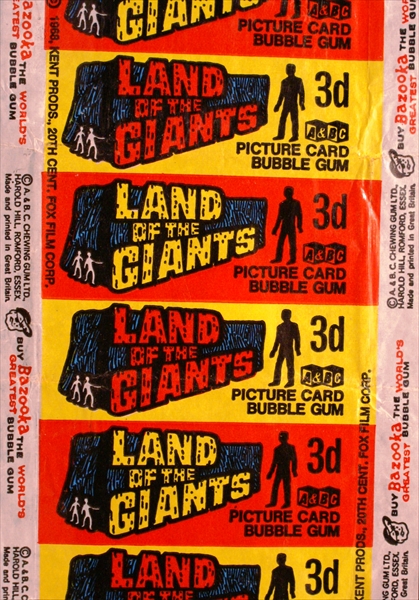
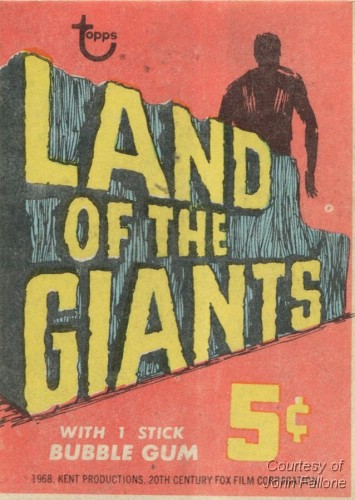
[above: Wrappers from Land of the Giants A&BC vs. original Topps test wrapper (a sticker on a white pack)]
Both sets are a little smaller (-.25 inch) in size, but they’re dramatically cheaper than their test counterparts. Land of the Giants test cards run upwards of $100 each, but an entire set of the UK version can be had for around $325 in Ex/Nrmt. Superman In The Jungle test cards are around $250 each, but complete UK sets fetch around $400 in Ex/Nrmt (although that doesn’t include the 16 piece puzzle set).
There are unusual similarities and differences between the two sets. One thing they both have in common is that the backs tell a sequential story. They don’t skip around and tell different events from the life of the main character, but rather, one continuous, unbroken narrative. That is pretty rare in non-sports cards, especially today. Topps didn’t invest much time on the backs on many of their cards during the 1960s. Puzzles filled out many and some included only a line or two of text. But both these sets had well developed stories.
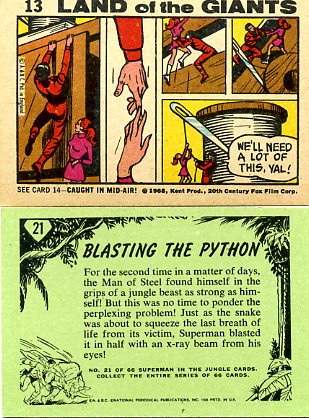
[above: Comparison of backs from Land of the Giants and Superman in the Jungle]
Land of the Giants has one of the more eye-grabbing backs of any series. The first 44 (of 55) cards recap how in 1983, a suborbital passenger transport heading for London passes through a “space warp” and lands instead on a planet inhabited by giant plants, animals, and humans. The entire story is depicted in a series of cool comic book images, about four or five panels per card. This set took obvious effort and it really shows. What a shame Topps didn’t use more comic strip backs on other sets. One glaring mistake is that their spaceship is drawn as a rocket, when the actual Spindrift looked more like an alien UFO. The irony is that the ship design was famous and shown in nearly every episode, and it even appears on the front photos. All the other characters are faithfully illustrated though, including Alexander B. Fitzhugh, the “villain” cast member who usually gets the rest of the crew in trouble the same way Dr. Smith did in Lost in Space (another Irwin Allen sci-fi production).
The next nine cards (45-54) are puzzle cards, and #55 is the checklist. The fronts have color photos from the show, most of which feature giant people, props, or animals dwarfing the regular cast. One downside to the comic strip panels is that there was no room left on the back to include info about the photo on the front. Additional text was crammed on the front (with the show’s logo), which blocks a rather large amount of the photo.
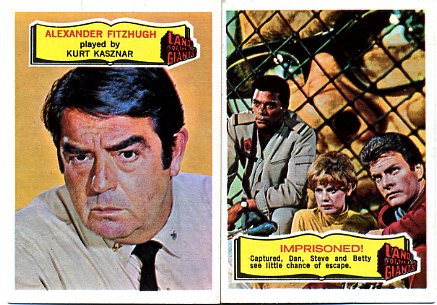
If you missed the series on TV, you missed the guessing game it caused in viewers who were trying to figure out just where this other planet was, and who the giants really were. They spoke English, knew about Earth, and had advanced technology including force fields, cloning, and teleportation devices, yet they did not have space travel and lived under a totalitarian government. It was all very mysterious and generated schoolyard debates the way Twin Peaks and Lost did.
In comparison, Superman in the Jungle left little to the imagination. After all, kids know more about Superman and Krypton’s history than they do our Presidents or planet’s past. This set also featured comic book panels, but they were on the front (with no word balloons) while the story text appears on the backs. The artwork was drawn by renowned Superman pencil artist, Al Plastino, and inked and colored by Norm Saunders, so it couldn’t get any better... except for the fact that Norm actually added all sorts of cool coloring effects that Topps made him remove because they thought it was too creative for their printers to reproduce. (But it’s still quite good.)

This series was created when Topps heard that Philly Gum nabbed the license to produce cards for NBC’s Tarzan TV show. The Tarzan cards ended up using a similar comic book style. It’s rather amusing to think of Topps and Philadelphia card companies circling each other like wrestlers, each looking for a shot to take the other one down. The high brass at Topps thought they could outdo Tarzan by sending Superman in the Jungle to battle it out with the animals and natives. (See Wrapper issue #212.) What must have seemed like a stroke of marketing genius came across as rather ridiculous, however, since animals and tribesmen are hardly any match for the Man of Steel. The writer made a valiant effort, nevertheless, adding Lex Luthor to the mix. Luthor levels the playing field (somewhat) by empowering several animals and a giant android with the powers of Kryptonite. There’s also a surprise ending and cameo appearance by another villain that explains a clever plot twist earlier in the story. Neat stuff!
Mention should also be made of the 16 piece die-cut puzzle, with one piece inside each pack. It forms a pulp cover style painting of Superman battling a lion by Norm Saunders. It is in stark contrast to the simpler comic book illustrations of the cards themselves. It’s very dramatic, although Superman’s face reminds more of Perry Mason!
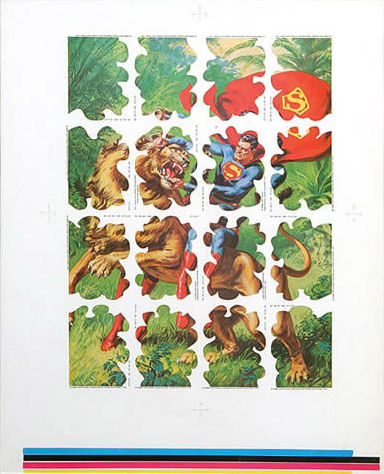
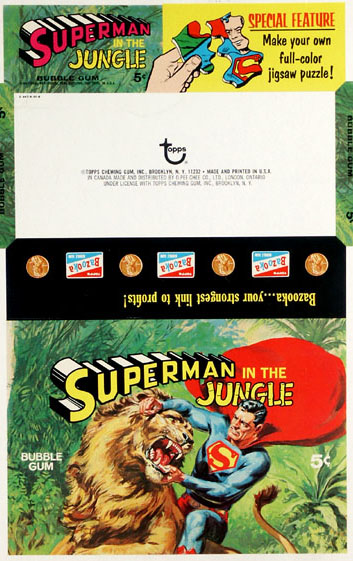
[above: Uncut sheet of the puzzle pieces and uncut sheet of the box]
It’s a pity these sets were only issued in the US as super rare test cards, beyond the reach of most collectors (myself included). So we’re indeed lucky that A&BC provided these cheaper, but no less worthy, alternatives.
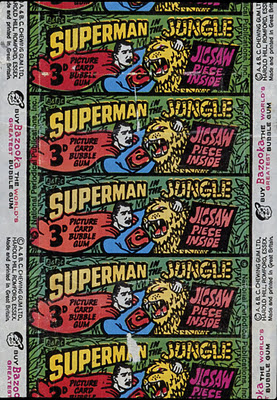
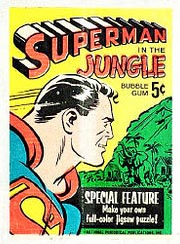
[above: Wrapper from Superman In The Jungle A&BC, and original Topps test pack (a sticker on white pack)]